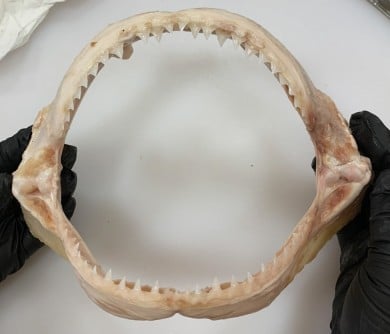
Research from the University of Adelaide’s School of Biological Sciences and Wildlife Crime Research Hub has unveiled alarming evidence of illegal shark products infiltrating both Australia and Aotearoa/New Zealand. The study, published in Pacific Conservation Biology, highlights distinct patterns in the movement of these products between the two countries. According to the findings, shark products were often smuggled in personal luggage and through postage, likely for personal use, as trophies, or for resale and consumption.
Most of the shark products seized upon entry to Australia originated from Asia, with fin products being the most commonly confiscated. In contrast, trophy items such as preserved specimens were more frequently traced back to the United States. “Over one third of chondrichthyan species, which includes sharks and shark-like rays, are currently threatened with extinction, with all threatened shark species also overfished,” stated Josephine Lingard, a PhD candidate at the University of Adelaide.
Global Trade and Regional Patterns
The global trade in shark meat has been on the rise since the early 2000s, driven by demand for shark fin soup—a delicacy and status symbol primarily consumed in Southeast Asia. However, the trade of legally collected shark fins, where sharks are brought to land with fins still attached, has been decreasing. This trend underscores the complexity of the shark product market, where legality and conservation efforts often clash.
In Aotearoa/New Zealand, Asia was also the most common origin for shark products, but Oceania followed closely, with Australia being the dominant country of origin in both passenger and mail seizures. Lingard noted, “We did not expect Australia to be a dominant country of origin for seizures in Aotearoa/New Zealand, given Australia showed a decline in the number of seizures over time and Aotearoa/New Zealand’s seizures increased.”
Geographic and Economic Factors
The unexpected prominence of Australia in this trade may be attributed to Aotearoa/New Zealand’s geographic position and its international flight connections. There is also the possibility that sharks are being caught, processed, and/or purchased in Australia before being transported to Aotearoa/New Zealand. Alternatively, Australia might simply serve as a stopover for travelers from other regions.
Challenges in Conservation Efforts
Lingard’s study utilized border seizure data from both countries to explore the origins of shark products and identify any country-specific trends over time. A significant challenge identified was the inconsistent data on the species of sharks involved in these trades, which complicates conservation efforts. “Less than 1 percent of seizures from both countries contained species-specific information, but 14 of the 18 seized species that were identified were listed on the Convention on International Trade in Endangered Species,” Lingard explained.
“The lack of species information across the datasets we reviewed matches general shark fisheries data where species are often grouped using harmonised system codes, which impedes conservation management of species and makes the monitoring of threatened species increasingly difficult.”
Efforts to improve the accuracy of species identification in wildlife seizures are crucial for understanding the patterns and drivers of the illegal wildlife trade and for implementing effective conservation strategies.
Future Directions and Institutional Developments
As the illegal trade of shark products continues to pose a threat to marine biodiversity, researchers and policymakers are urged to enhance cross-border cooperation and data sharing. This will aid in the development of more effective conservation policies and enforcement mechanisms.
In a related development, the University of Adelaide and the University of South Australia are set to merge, forming a new major institution—Adelaide University, which will open its doors in January 2026. This merger aims to strengthen research capabilities and foster academic excellence in addressing pressing global issues such as wildlife conservation.
For more details on the new university and its initiatives, interested readers can visit the Adelaide University website.




